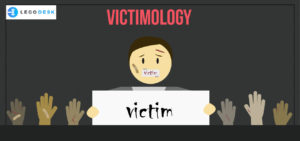Article on Victimology

VICTIMS, VICTIMIZATION, AND VICTIMOLOGY
When we see the word victims the first question that comes to our minds is, who are victims? And what do we know about them? This word seems to have a very straight forward definition, but in reality, the answer to the questions relating to this concept can be very open-ended and have the highly elaborate and broad approach.
The most known category of victims is those who have been personally affected by ‘conventional crimes’, such as assaults or property loss or damage that, are most likely to be recorded by the police. What we ‘know’ about even these victims is both contingent and contested, however, depending as it does on the type of discourse – academic, administrative, legal, media, political – from which it is derived, the purpose for which has been compiled and the methodology on which it is based.[1]
One helpful starting point in exploring ‘what we know’ about the identity and attributes of victims is the celebrated stereotype of ‘the ideal victim’. In Christie’s perceptive there are six attributes that at the level of social policy are most likely to result in the conferring of complete, legitimate and unambiguous victim status on someone who has had a crime committed against them. Paraphrasing Christie, the six attributes are:[2]
- The victim is weak in relation to the offender – the ‘ideal victim’ is likely to be either female, sick, very old or very young (or a combination of these).
- The victim is, if not acting virtuously, then at least going about their legitimate, ordinary everyday business.
- The victim is blameless for what happened.
- The victim is unrelated to and does not know the ‘stranger’ who has committed the offense (which also implies that an offender is a person rather than a corporation; and that the offense is a single ‘one-off’ incident).
- The offender is unambiguously big and bad.
- The victim has a perfect blend of power, sympathy to effectively evoke the victim status without threatening which risks the opposition from strong countervailing vested interests.
VICTIMIZATION
Victimization is a very complex process that has n number of possible elements. whatever interaction may have taken place between an offender and ‘victim’ during the commission of the offense, plus any aftereffects arising from this interaction or from the offense itself. The second element encompasses ‘the victim’s’ reaction to the offense, including any change in self-perception that may result from it, plus any formal response that s/he may choose to make to it.[3] The third element consists of any further interactions that may take place between ‘the victim’ and others, including the various criminal justice agencies with whom s/he may come into contact as a result of this response. Secondary victimization is when this interaction becomes negative in nature.[4]
VICTIMOLOGY
Victimology as a field of study is a recently developed sub-discipline of criminology. Whereas criminology is very broadly concerned with the study of crime and criminals, victimology focuses equally broadly on crime and its victims. As within criminology itself, however, individual victimologists have tended to focus on very different sets of issues, as a result of which a number of variants within the sub-discipline may now be differentiated. Victims, victimization, and victimology
The position within victimology is further complicated by the fact that the academic study of victimology is closely intertwined with and is consequently almost impossible to disentangle from the similar diverse philosophies and practices that have been adopted by various sets of activists who have championed the cause of victims. Further, we will see three principal variants within the field of victimology positivist, radical and critical victimology is briefly described.
Positivist victimology
Positivist victimology is influenced by the view of a crime, along with all other natural and social phenomena, is caused by factors and processes which can be discovered by scientific investigation. But whereas positivist criminologists attribute the causes of crime to various forces (including environmental and genetic factors) that act upon offenders and are beyond their control, early positivist victimologists were interested in the possibility that certain victims might in some way contribute to their own victimization.[5]
Radical victimology
Radical victimology resembles its criminological counterpart in rejecting the theoretical concept of positivist victimology. Instead of seeing victimization as a product of the personal attributes of individual victims, structural factors relating to the way society is organized, and also the role of the state itself and the legal system in the social construction of both victims and offenders.[6]
Critical victimology
Critical victimology has highlighted the importance of historical and cultural contexts in shaping both victimizing practices and our sensitivities towards them. Even more importantly, critical victimology should make us aware of the fact that concepts such as ‘victim’ and ‘victimization’ are debatable and are being historically and culturally specified both malleable and far from universal perception.
[1] Understanding Victims And Restorative Justice, By Dignan, James
[2] Criminology, By Tim Newburn
[3] Supra 1
[4] Foundations for Offender Management: Theory, Law, and Policy for Contemporary …, By Anne Robinson
[5] Supra 1
[6] Supra 2
Try our Debt Resolution solutions today Request a Demo